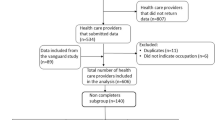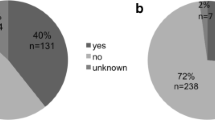Abstract
Goals of work
It is well documented that an increasing proportion of cancer patients today use complementary and alternative medicine, mostly alongside conventional therapies. This study investigates the use of complementary and alternative medicine among oncology health workers and the reported effects.
Patients and methods
In June 2002, we conducted a national multicentre survey including 828 Norwegian oncologists, nurses, clerks and therapeutic radiographers. The response rate was 61.5%.
Main results
We found that females were more often users of both complementary and alternative methods than males (39% versus 15% and 47% versus 17%) and that few oncologists had tried such treatments compared to nurses, therapeutic radiographers and clerks (20/12% versus 50/40%, 41/33% ,and 31/50%). Interestingly, the majority of those who had tried unconventional methods reported some or very good effects. Acupuncture, homeopathy, aromatherapy and massage were the most popular therapies. Sub-group analyses including only oncologists showed that female physicians were more often users of both complementary and alternative methods compared to males (33% versus 12%, 25% versus 3%). Moreover, participants below the age of 35 years and Christians more often reported use.
Conclusions
This survey demonstrates that significant proportion of oncology health workers in Norway have used non-proven therapies and that most have had a positive experience. Differences in use is highly dependent on gender, profession, age and religion.
Similar content being viewed by others
References
Aasland OG, Borchgrevink CF, Fugelli P (1997) Norwegian physicians and alternative medicine. Knowledge, attitudes and experiences. J Norweg Med Assoc 117:2464–2468
Botting DA, Cook R (2000) Complementary medicine: knowledge, use and attitudes of doctors. Complement Ther Nurs Midwifery 6:41–47
Breslow NE, Day NE (1980) Statistical Methods in Cancer Research. The analysis of case-control studies. IARC Scientific Publications No. 32. Lyon, International Agency for research on cancer
Cassileth BR, Schraub S, Robinson E, Vickers A (2001) Alternative medicine use worldwide: the International Union Against Cancer survey. Cancer 91:1390–1393
Crocetti E, Crotti N, Montella M, Musso M (1996) Complementary medicine and oncologists’ attitudes: a survey in Italy. Tumori 82:539–542
Crocetti E, Crotti N, Feltrin A, Geddes M, Buiatti M (1998) The use of complementary therapies by breast cancer patients attending conventional treatment. Eur J Cancer 6:337–47
Damkier A, Elverdam B, Glasdam S, Jensen AB, Rose C (1998) Nurses’ attitudes to the use of alternative medicine in cancer patients. Scand J Caring Sci 12:119–126
Anonymous (1998) Alternative medicine. NOU 1998:21 ISSN 0333–2306, Elanders, Oslo
Ernst E, Cassileth BR (1998) The prevalence of complementary/alternative medicine in cancer: a systematic review. Cancer 83:777–782
Ernst E, Cassileth BR (1999) How useful are unconventional cancer treatments? Eur J Cancer 35:1608–1613
Fisher P, Ward A (1994) Complementary medicine in Europe. BMJ 309:107–111
Laerum E, Borchgrevik CF, Wiens G (1985) Who goes to the homeopath? Why, with which complaints and what is done? J Norweg Med Assoc 105:2478–2482
Lannoye P (1997) Report on the status of non-conventional medicine. Committee on the environment, public health and consumer protection. PE 216.066
Lee MM, Lin SS, Wrensch MR, Adler SR, Eisenberg D (2000) Alternative therapies used by women with breast cancer in four ethnic populations. J Natl Cancer Inst 92:42–47
Lippert MC, McClain R, Boyd JC, Theodorescu D (1999) Alternative medicine use in patients with localized prostate carcinoma treated with curative intent. Cancer 86:2642–2648
Lynoe N, Svensson T (1992) Physicians and alternative medicine- an investigation of attitudes and practice. Scand J Soc Med 20:55–60
Miller M, Boyer MJ, Butow PN (1998) The use of unproven methods of treatment by cancer patients. Frequency, expectations and costs. Support Care Cancer 6:337–347
Munstedt K, Entezami A, Wartenberg A, Kullmer U (2000) The attitudes of physicians and oncologists towards unconventional cancer therapies (UCT) Eur J Cancer 36:2090–2095
Pedersen EJ, Norheim AJ, Fonnebe V (1996) Attitudes of Norwegian physicians to homeopathy. A questionnaire among 2 019 physicians on their cooperation with homeopathy specialists. J Norweg Med Assoc 116:2186–2189
Perkin MR, Pearcy RM, Fraser JS (1994) A comparison of the attitudes shown by general practitioners, hospital doctors and medical students towards alternative medicine. J R Soc Med 87:523–525
Raben H, Jørgensen KC, Aggernaes KH (1993) Use of alternative treatment among hospital staff in a psychiatric and rheumatology department. Ugeskr Laeger115:803–806
Risberg T, Kolstad A, Johansen A, Vingerhagen K (1999) Opinions on and use of alternative medicine among physicians, nurses and clerks in northern Norway. In Vivo 13: 493–498
Risberg T, Lund E, Wist E, Kaasa S, Wilsgaard T (1998) Cancer patients use of nonproven therapy: a 5-year follow-up study. J Clin Oncol 16:6–12
Salmenpera L, Suominen T, Lauri S (1998) Oncology nurses’ attitudes towards alternative medicine. Psychooncology 7:453–459
SAS Institute INC (1988) SAS Procedures Guide, Release 6.03 edn, SAS Institute, Cary
Visser GJ, Peters L (1990) Alternative medicine and general practitioners in The Netherlands: towards acceptance and integration. Fam Pract 7:227–232
Author information
Authors and Affiliations
Corresponding author
Rights and permissions
About this article
Cite this article
Kolstad, A., Risberg, T., Bremnes, Y. et al. Use of complementary and alternative therapies: a national multicentre study of oncology health professionals in Norway. Support Care Cancer 12, 312–318 (2004). https://doi.org/10.1007/s00520-004-0590-9
Received:
Accepted:
Published:
Issue Date:
DOI: https://doi.org/10.1007/s00520-004-0590-9




